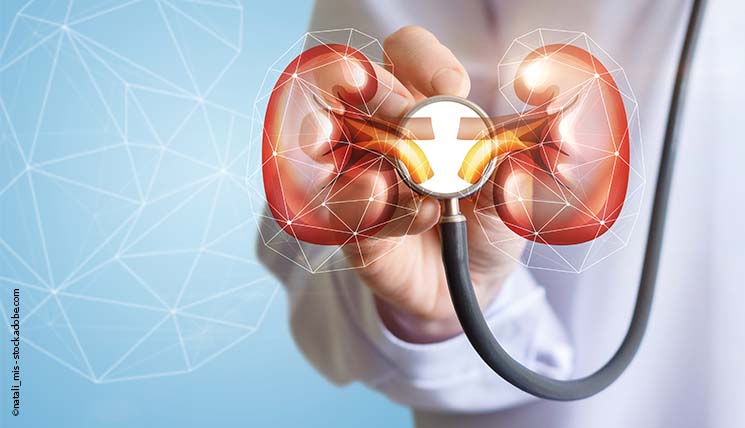In October 2021, the organisation KDIGO (Kidney Disease: Improving Clinical Outcomes) published an updated version of the clinical guideline for the management of patients with glomerulonephritis. This guideline contains recommendations for diagnostics in primary membranous nephropathy, an autoimmune kidney disease that is characterised in most cases by the occurrence of autoantibodies against PLA2R and/or THSD7A. The detection of two antibodies in the scope of diagnostics of this disease is protected by patents exclusively in-licensed by EUROIMMUN.
Membranous nephropathy is a chronic inflammatory kidney disease that can lead to complete kidney failure in the worst case. In 20-30% of cases, it develops as a secondary disease from an underlying condition (e.g. an infection, another autoimmune disease, a tumour disease or drug poisoning). In the majority of patients, however, the inflammation of the renal glomeruli is due to autoantibodies, which are directed against the two proteins phospholipase A2 receptor (PLA2R) and thrombospondin type 1 domain-containing 7A (THSD7A). It was not until 2009 and 2014 that the autoantibodies against PLA2R and THSD7A, respectively, were identified as contributing to the primary form of membranous nephropathy (pMN).
Even though the exact pathogenic mechanisms for the development of pMN have not yet been conclusively clarified, it is now widely accepted that autoantibodies play a pathogenic role. The relevance of anti-PLA2R antibodies in particular, which with a prevalence of 70% to 80% are significantly more frequent than anti-THSD7A antibodies (prevalence: 2% to 5%), has been confirmed by intensive research. Accordingly, the benefit of the biomarker was also acknowledged in the new guideline.
Anti-PLA2R antibodies are now considered a diagnostic marker of pMN. Diagnosis can even be made without a biopsy of the kidney tissue if the patient shows the serological characteristics, i.e. antibodies against PLA2R, of the disease in addition to the clinical symptoms. The fact that this is now possible according to the guideline emphasises the reliability and relevance of anti-PLA2R antibodies as a biomarker of pMN, since no other glomerulonephritis can currently be diagnosed without a biopsy.
In addition, the concentration of anti-PLA2R antibodies provides information on the activity and possible progression of the disease and is one of the clinical criteria used to assess the risk of progressive renal failure in pMN patients. The higher the antibody concentration, the more active the pMN and the higher the risk of kidney failure.
Furthermore, a decrease or increase in the anti-PLA2R antibody level usually precedes an improvement or worsening of the disease, respectively, so that phases of clinical remission and relapses can both be predicted by monitoring the antibodies.
The anti-PLA2R antibody level can also be used to assess a patient’s response to immunosuppressive therapy. According to the guideline, the antibody concentration should be measured three or six months after the start of therapy. The determined value serves as a basis for maintaining or adjusting the current treatment.
The predictive value of the anti-PLA2R antibody concentration also applies in connection with kidney transplantation: High antibody titers before a transplant indicate a high risk of a pMN relapse. After transplantation, regular determination of the antibody level helps to predict possible relapses early and to intervene to prevent them.
As anti-THSD7A antibodies are primarily found in anti-PLA2R-negative pMN patients, they have a complementary role in pMN diagnostics. The serological detection rate can be increased by parallel determination or a two-step screening strategy in which patients with seronegative anti-PLA2R results are tested for anti-THSD7A antibodies.
EUROIMMUN was the first company to develop commercial CE-marked test systems for the detection of the two autoantibodies and to protect this scientific technological success by patents. Thus, we offer exclusive products for pMN diagnostics in the different countries with patent protection.
Three different test systems are available for the determination of antibodies against PLA2R: an indirect immunofluorescence test (IIFT), an ELISA and a chemiluminescence immunoassay (ChLIA). The IIFT allows sensitive qualitative to semiquantitative determination of human IgG against PLA2R, while ChLIA and ELISA enable reliable quantification of the antibody concentration. The detection of anti-THSD7A antibodies is possible by IIFT.
Also visit our website www.pla2r.com for further information and current webinars or contact our experts.


